Expanded clay screed: an overview of 3 device options and installation nuances
Expanded clay has remarkable heat-insulating properties. It is actively used in the process of building foundations, building floors between floors, and even for attics. Only 10 cm of expanded clay gravel is warmer than 30 cm of wood and 100 cm of brick wall. Expanded clay is also ideal for underfloor heating. It is only important to use this unique material in the screed technologically competently - and there are three such options.
To get started, we offer you a couple of orientation videos:
Content
Advantages and disadvantages of expanded clay
Expanded clay is obtained according to a special technology: special grades of clay are burned at high temperatures. Small granules with a porous structure are obtained, which have a number of important advantages:
- Environmental friendliness
- Durability
- Thermal insulation
- Soundproofing
- Strength
And while all expanded clay is quite affordable. Not only its one drawback is not happy - instability to moisture, and this already implies some limitations in use.
Expanded clay is often used as a heater and for noise insulation of residential buildings and industrial premises. Read more about the material and how to use it in the article:https://floor.expertexpro.com/en/ustroistvo-rmnt/uteplenie-pola-keramzitom.html.
Types of expanded clay backfill for screed
The density of expanded clay, which the market offers today, today ranges from 250 to 600 kg / m3, according to which these types are distinguished:
- Expanded clay rubble. This material is 10-14 mm in size, and it is more often used for the preparation of concrete.
- Expanded clay gravel. This one is used for mounting strong and light floors, and has three categories: 5-10 mm, 10-20 mm and 20-40 mm.
- Expanded clay sand. It is used for thin couplers, the size does not exceed 5 mm.
The choice of the type of fraction depends on which room you will be screeding with expanded clay and in which technology.
We use expanded clay in the screed: 3 options
So, the standard recipe for a living room is a package of 50 kg per 60 kg of cement-sand mixture. But for industrial premises, where the floor load is more significant, other proportions are needed. Let's just say that expanded clay can not withstand high pressure, and therefore is not suitable for warehouses with equipment.
Semi-dry screed with expanded clay: we insulate and raise the floor
Semi-dry screed with expanded clay is the only option in which there is no need for thorough preparation of the base. It is only necessary to sweep and remove construction debris from the cracks. And so that there is no moisture, of course.
If there are wires under the floor, we hide them in the corrugation and press them well to the base. After cleaning, we cover everything with an integral PVC film or special vapor barrier, for example, a glassine for a wooden floor. Its task is to protect expanded clay from moisture from below, which often forms on the floor. It is necessary to lay the film with an overlap, fixing it with tape.
Now mark the level of the new screed. This is best done with a professional laser level. We beat off the lines on the wall and repeat them with an ordinary pencil or marker. If there is no laser, use the usual rack level.
Along the walls, we now leave a gap of 10 cm, where we insert the insulating material. In addition, it will provide good sound insulation. In extreme cases, use a standard edging tape with a thickness of one centimeter and a width of ten. Now pour the expanded clay from the bags and distribute it over the entire surface of the floor with the usual rule.
And then you can already follow two ways: pour the solution directly on expanded clay, or separate it with a thin waterproofing layer.
In the first case, you need to pour expanded clay with cement milk in advance. Expanded clay granules are hygroscopic, and moisture is absorbed quickly due to porosity. Therefore, if you do not make such a preparation, this water will be pulled out of the dry granules from the screed, and it will cause uneven shrinkage. But even with preliminary wetting, it cannot be guaranteed that the water from the screed will not go to backfill at least a little.
A semi-dry floor screed is used to level the base and serves as the foundation plate for the finish. You will learn more about the device of this gender and the secrets of the right technology from the material:https://floor.expertexpro.com/en/viravniv-stazhka/polusuxaya-styazhka-pola.html.
In the second case, this does not threaten, because even ordinary plastic film will easily prevent moisture from getting into the bedding. But then you need to be very careful so that the film does not tear anywhere.
Concrete screed with expanded clay, or expanded clay concrete
Before installing a concrete screed with expanded clay, i.e. expanded clay concrete, put the "diagnosis" base. Just determine how uneven the floor is:
- Step 1. To do this, pick up the usual two-meter level, put dots in the corners of the room, and find the centers of the line connecting the walls and floor.
- Step 2. After that, divide the space into segments and check each section individually.
Based on the detected curvature of the floor, calculate how thick the new screed will be. Now it’s important to make the right solution: pour the granules into a large metal bathtub and pour enough water so that it is exactly half a palm above the expanded clay level. Part of the water is absorbed because granules have a porous structure. Just mix expanded clay with water until the mixture changes color. After that we add sand and cement.
Expanded clay needs to be distributed between beacons too. Level well, and let dry for two days. Next, you can make another such layer or already proceed to finish the floor.
For serious irregularities, ready-made solutions from Vetonit are also suitable - these are mixtures where expanded clay crushed stone is held on a cement-containing binder. Such a leveler is able to smooth out any irregularities, even those that reach 30 cm. By the way, such a screed even dries faster than regular concrete.
Dry screed with expanded clay: modern technology
Dry screed with backfilled expanded clay recently gaining more and more popularity. The essence is simple: expanded clay is poured onto a plastic film, carefully leveled, and on top of it - GVL plates. But in the process there are many subtleties, of course.
So, here is a detailed instruction on how to make a screed with expanded clay:
- Step 1. On a clean prepared surface we put waterproofing - a film. We put an overlap, on 20 cm of approach, and 6-7 cm on each wall. We close the joints of the film with construction tape.
- Step 2. Around the perimeter of the room at the joints with the walls we close the film with a damping tape.
- Step 3. We put the beacons - profiles to align the expanded clay well. It is not difficult to determine their height and location: first we set the laser level in the center of the room. Then, 0.5 cm from the corner that is opposite the door, we screw a self-tapping screw into the floor. We put a rule on it and mark the point of its intersection with the line of the laser level. From it, after 20 cm, we screw in the second self-tapping screw so that it clearly passes along the intended line. And so - the whole room. The distance between parallel lines should not be longer than the rule.
- Step 4We spread cement mortar on each self-tapping screw, on top of it there is a profile, and we press everything well. We remove the remains of the mixture with a spatula.
- Step 5. We wait until the mixture under the lighthouses is completely dry, and we fill in expanded clay portions. Leveling. After the backfill is completed, be sure to check the profiles as a rule - they should not bend.
- Step 6. In addition, we fill the filling with a polyurethane foam grater. As soon as we align one section, we lay sheet material on it. It is desirable in two layers, fastening each of them with glue and self-tapping screws, especially if the sheets are thin.
- Step 7. We close the joints with putty. If desired, you can cover the sheets with bituminous waterproofing.
Step 8. After stacking the sheets, trim the remaining film and tape.
All! The screed is completely ready for laying the topcoat.
You can familiarize yourself with the general rules and tips for installing floor screed of any design in a special article on our website:https://floor.expertexpro.com/en/viravniv-stazhka/ustrojstvo-styazhki-pola.html.
Here are the main advantages of a dry screed with expanded clay:
- Strong and absolutely flat floor base that can withstand a load of 500 kg per square meter.
- Hypoallergenicity and the absence of any harmful volatile substances in the air.
- No cracks, no faults, no chips, as with a conventional screed.
- Ready for use immediately after installation.
- Good soundproofing.
- The floor is so warm that it does not need any additional systems.
- The shortest time to complete the work: even a fairly spacious room, one working team will line out in just 3 hours.
You can mount absolutely any coating on the finished surface: parquet, porcelain stoneware, laminate or even tile. You can’t only water a warm floor - only electric, and preferably film in general. Such a dry screed with expanded clay is especially valuable in that it practically does not create an additional load on the floor slab.
But ordering the performance of such a screed on an ad is quite risky - violations of the technology will cause the floor to “cobble” when walking, and certainly will not be even. So, you should be alerted if the workers you hired:
- Expanded clay is not used in large fractions, but crushed.
- Instead of sheets GVLV put those that are not intended for such work. For example, gypsum flakes.
- The gap between the wall and the sheets is too large.
- The folds at the edges of the wall junction were not cut.
- The sheets are fastened together not with glue, but with mounting foam.
And so it happens that fairly high-quality materials are used unprofessionally, and such a screed subsequently bends even under a person. This is where the myths that only “wet” or semi-dry screeds appear are the only normal method to make a smooth and durable floor.
But you must admit that any success depends on how you get to business, and this is especially important in the field of construction.

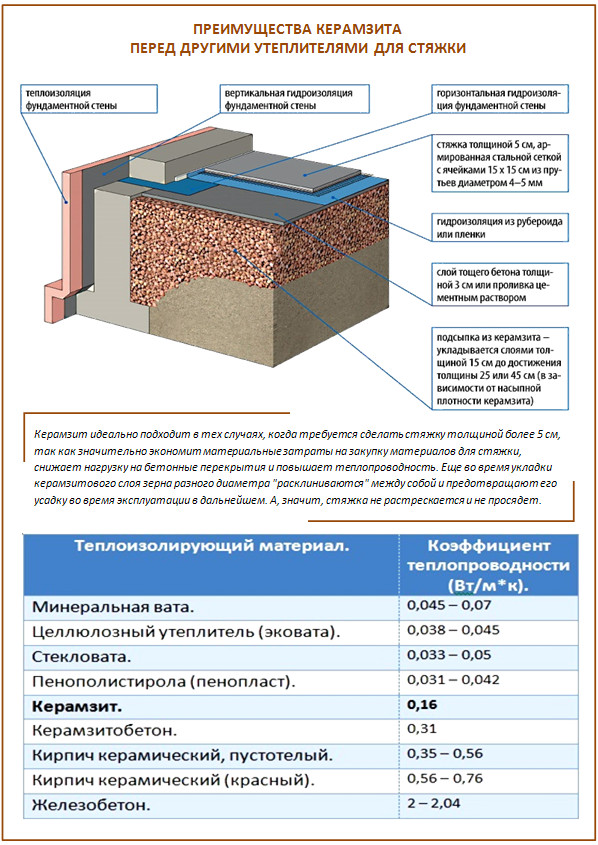

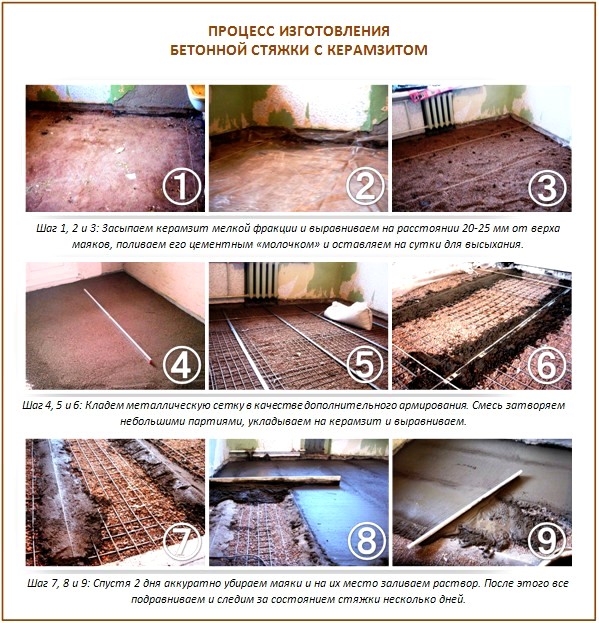
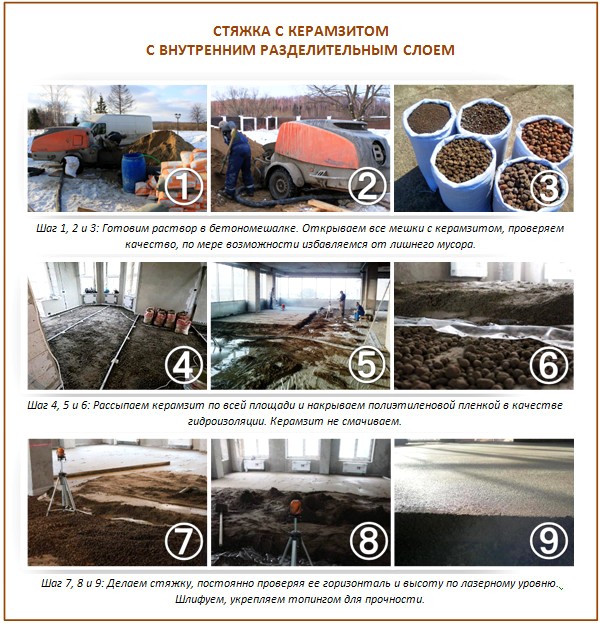
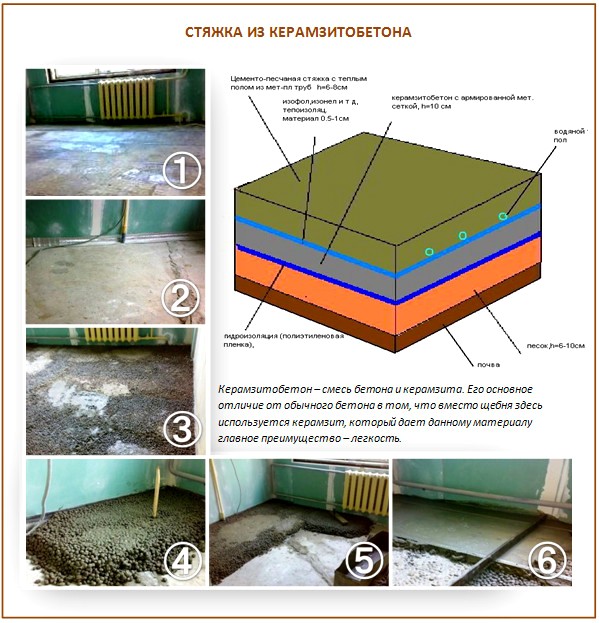
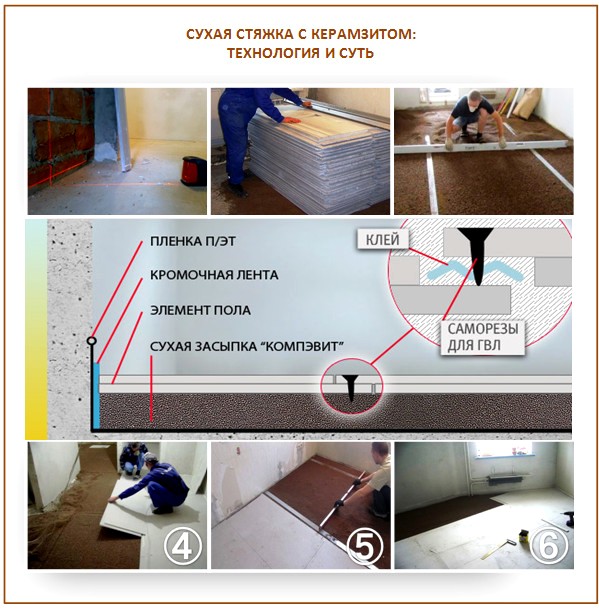

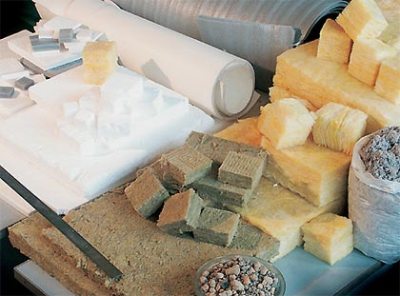
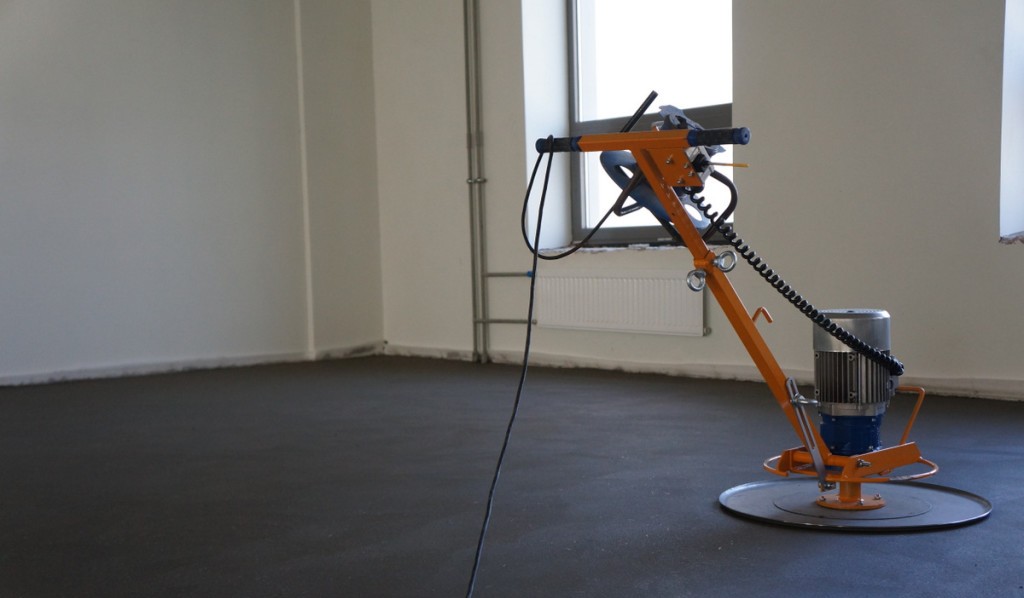
7 comments